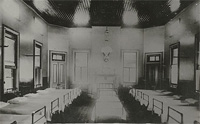Women gather for Cootamundra Girls Home anniversary
ABC Riverina August 10, 2012
Indigenous women and their families from across Australia have started arriving in the Riverina for the centenary of the Cootamundra Girls Home.
Hundreds of girls were forcibly taken from their families and placed at the Cootamundra Domestic Training Home for Aboriginal Girls between 1911 and 1968, as part of the Commonwealth's assimilation policy.
The girls were not allowed to contact their families and were later sent to work as domestic servants.
Organiser and Wiradjuri elder Bob Glanville says it'll be an emotional time.
"Words can't express how important it is to the girls that are coming home and their families," he said.
"It's an opportunity to meet up with old friends and relatives and re-live some of the good memories, cause all they had them days, was one another.
"But it's also an unhappy trip down memory lane, thinking of all the years, they didn't get to spend with their families, and some of them are still looking for their families."
There is hope the 100th anniversary of the home, will educate a new generation about Australia's former assimilation policy.
Mr Glanville says the event will play an important role in the healing process.
"The younger people of today, they really need to know what a terrible time that was and how it still impacts on so many Aboriginal families after all these years," he said.
"A generational affect of the assimilation policy.
"A terrible, terrible time, in Australian history."
Girls from the Cootamundra Aboriginal Girls’ Training Home in New South Wales where Aboriginal children were forcibly taken by the Aboriginal Protection Board
The governments said children had to be taken away from their parents because the influence of their own communities was immoral and they were in danger of abuse and neglect, but the real agenda was to de-Aboriginalise them.
The former Cootamundra Aboriginal Girls' Training Home provides tangible evidence of the Government policy and practice of taking Aboriginal children away from their families and communities, severing all ties with their culture in order to assimilate them into mainstream Australian society. Placement of Aboriginal girls in the institution of the Cootamundra Girls' Home has caused cultural dislocation for the former residents and ongoing associated problems within the Aboriginal community. The place as a means to reconnect to the past is associated with commemoration and healing of these individuals and communities.
The former Cootamundra Aboriginal Girls' Training Home provides historical evidence of the Government policy of assimilation that was based on Social Darwinism or the premise that "full blood" Aborigines would die out and the "mixed race" Aboriginals would soon have their Aboriginality bred out. The former Home is evidence of the plan to train Aboriginal girls to become domestic servants demonstrating the prevalent ideology of the early to mid twentieth century that Aboriginal people were inferior in intelligence and only fit to become the servants of the rest of society.
The Cootamundra Aboriginal Girls' Training Home provides an example of the historical practice of Aboriginal wards of the State being denied their Aboriginality and cultural heritage which was the subject of a National Inquiry into the Separation of Aboriginal and Torres Strait Islander Children from the Families in 1997 (Commission of Inquiry). The nation was made aware of how widespread the practice of removal was, which affected every Aboriginal community but was outside the consciousness of mainstream Australians. The Cootamundra Girls' Home provides contemporary Australia with physical evidence as a means to comprehend the pain and suffering of past assimilation practices.
Call for records from Cootamundra Girls Home
May 29, 2012 ABC News
Organisers of the Cootamundra Girls Home centenary want people with records of the stolen generations who lived there to come forward.
More than 500 people are expected to attend the Centenary of the Girls Home, on August 11.
Bob Glanville from the Organising Committee says there will be no retribution against anyone worried about holding some of the history.
He is confident there are records hidden away in Cootamundra back sheds.
"What happened in the past, records, important records have gone missing for one reason or another," he said.
"And a lot of the history of the girls at the Home has gone, but we know that a lot of it is still out there somewhere in the community.
"People that are listening, I urge them if they've got any records, any photographs anything to contact us.
"We would certainly look after those things.
"And for people who think they may have some records of those sad days and perhaps they shouldn't have them and they're a little bit apprehensive about coming forward, there'll be no penalty to them at all."
There will be some emotional reunions at the Girls Home, when members of the stolen generations meet up with old friends in August.
Mr Glanville says one farmer who took one of the Cootamundra girls for a holiday in the 1960s, learnt only a few weeks ago the Aboriginal girl had been taken from her family.
"They found out that she wasn't an orphan and they thought they were just sponsoring her for a holiday," he said.
"Asked me, did I know the girl?
"I didn't but I knew people who would have known.
"So I made a few phone calls - and they did, they got in contact with the girl, who got in contact with the farmer and his wife and some good memories were brought back and I'm sure they'll be coming back for the event as well."








